All 2 entries tagged Design Methods
No other Warwick Blogs use the tag Design Methods on entries | View entries tagged Design Methods at Technorati | There are no images tagged Design Methods on this blog
July 01, 2009
Slides from a presentation on the 3 types of learning/design space
Follow-up to Design Thinking – Tim Brown from Inspires Learning - Robert O'Toole
Here are some slides from a presentation that I gave today on learning space design, using Tim Brown's model of design spaces. I've taken out the copyrighted material from Brown's HBR article, as well as slides that apply this approach to an analysis of Warwick blogs. My core message was: design and use different learning spaces for different purposes - be clear, is a space inspirational, ideational, implementational? In which if these ways should students behave at a specific time?
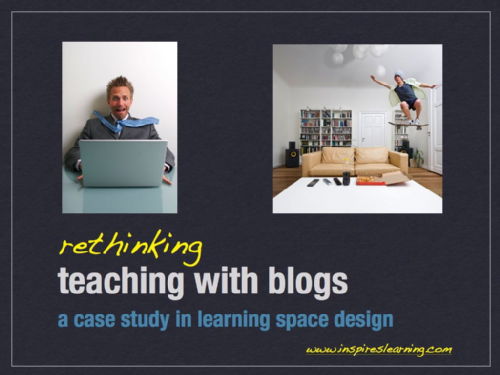
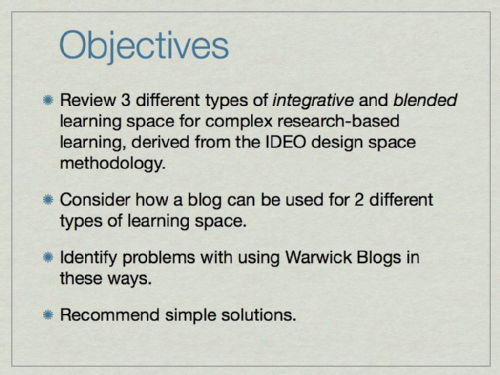
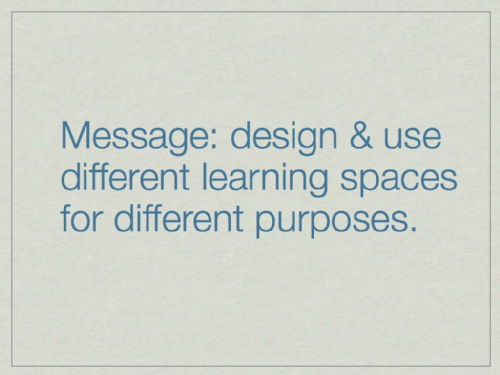
I then presented the design spaces diagram and some quotes from Brown's article (not shown here for copyright reasons).
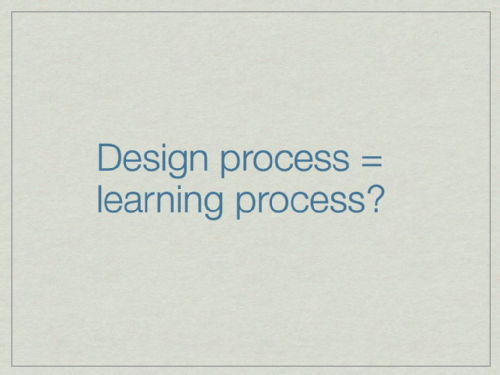
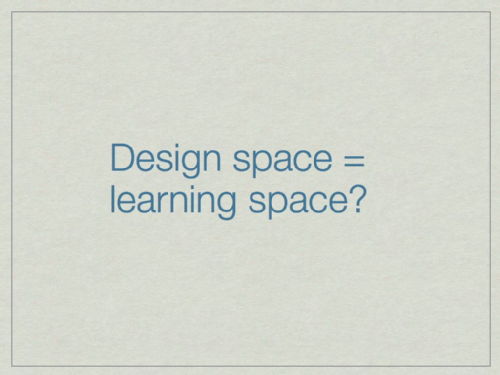
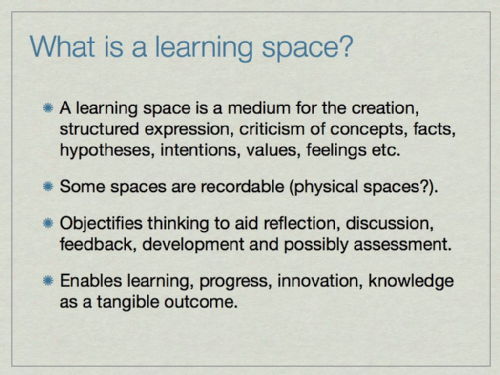
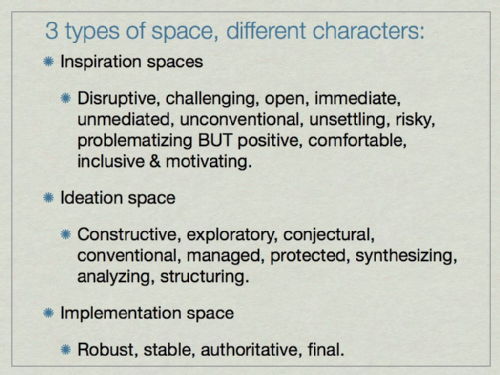


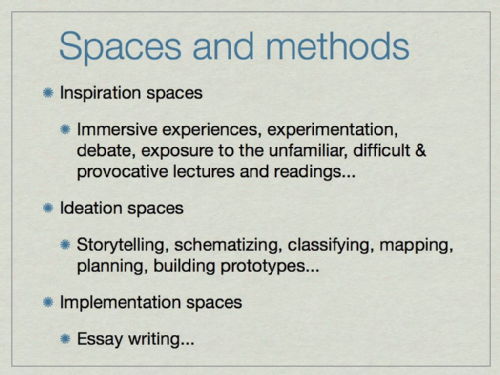
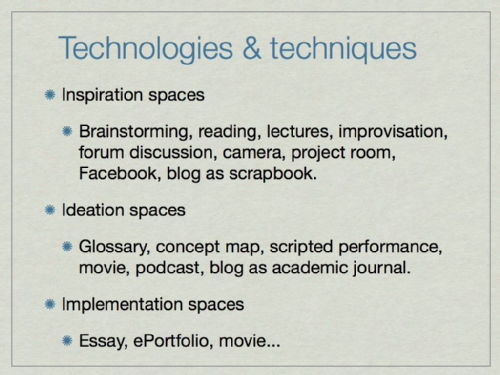
I then went on to consider how Warwick Blogs can used as an inspirational space and as an ideational space. This dual-purpose can be confusing, and a barrier to the use of blogs for teaching and learning.
June 29, 2009
Design Thinking – Tim Brown
In this entry I discuss the argument that good design (and problem solving) depends upon the maintainance of three seperate types of activity. I go on to consider how this might apply to teaching, and how learning spaces might be designed and used to support this approach.
Introducing "design thinking"
I've just read the article Design Thinking1 by Tim Brown of the design company IDEO (available as a PDF), in which the author argues for the adoption of a design attitude and methodology in addressing all kinds of difficult problems (from service design to political and social). From a page on the IDEO web site in which they talk about their methods:
An inherently shared approach, design thinking brings together people from different disciplines to effectively explore new ideas—ideas that are more human-centered, that are better able to be executed, and that generate valuable new outcomes.2
The article promotes good design practices, such as prototyping, iteration, storytelling and empathic design, bundled together into the process of design seen as a collective non-linear collaboration of simultaneous acts of experiencing (using, feeling, participating), responding systematically (conceptualizing, creating narratives, prototyping), and manufacturing. It is almost as if these three activities are distinct but interdependent design faculties (and yes I mean that in a quasi Kantian sense). The article contains a nice diagram, with a large impressionistic circle divided unevenly into three blobs connected by bi-directional flows:
- Inspiration
- Ideation
- Implementation (drawn as smaller than the other two)
It gets even more interesting when Brown states that:
The design process is best described metaphorically as a system of spaces rather than a pre-defined series of orderly steps. The spaces demarcate different sorts of related activities that together form the continuum of innovation.3
A continuum of faculties/spaces, not a process
Consider the three spaces to be three inter-dependent faculties. Inspiration is the essential perceptual apparatus that seeks to experience the world as real people do (rather than as stick people on use case diagrams). But the important message is that the designer must not ever switch their faculty of inspiration off, or allow it to be filled with prejudices coming from ideation and implementation - you may think you have a perfect design, but don't get carried away. And that's why it's important to think of the spaces as being constantly and simultaneously active: not a sequence but a continuum:
...the process makes sense and achieves results, even though its architecture differs from the linear, milestone-based processes typical of other kinds of business activities.3
Implications for teaching
The IDEO approach addresses one of the most common errors encountered in both design projects and independent student led investigative learning: becoming locked into a seemingly adequate solution before the problem domain and the array of possible responses has been thoroughly explored. The message for designers and for students is thus: keep yourself open to new and potentially disruptive experiences (facts, feelings etc), keep coming up with new narratives and prototypes (concepts, arguments, stories, structures), before becoming too locked into producing the final result - and even then be prepared to be agile.
Implications for learning space design
For both designers and for students it is important to sustain all three of these design faculties, even when concentrating upon one more than the others. Brown's argument suggests that separate physical spaces need to be maintained, so that the designer (student) can move from one faculty to another (even though earlier he described the model as "metaphorical"). In his diagram he suggest:
Have a project room where you can share insights, tell stories.4
A kind of reflective space for reporting back from the outside world, from the source of all inspiration (a blog could be the online equivalent). If one were to create three such offline or online spaces, one would aim to make them distinct and tailored to each type of activity, not simply for functional reasons, but also to encourage a change of behaviour as students move between the spaces.
Perhaps it would be wise to encourage each student to spend time in each of the spaces? So that, for example, they avoid becoming too deeply embedded in implementation issues, and lose their connection with inspirational experiences.
This now suggests a way to redesign activities that I will be teaching as part of the MA in International Design and Communications Management.
I would be interested to hear from anyone who has taught in this way, or experienced such design spaces.
________________
1 Brown, T. Design Thinking, Harvard Business Review, June 2008.
2 Approach - Thinking - IDEO, http://www.ideo.com/thinking/approach/ [Accessed 29/06/09]
3 Brown, T. p.88
4 Brown, T. p.89
________________
An article on design thinking in education, by Alice Daniel, can be found at http://findarticles.com/p/articles/mi_qa3797/is_200702/ai_n18706046/
 Robert O'Toole
Robert O'Toole

 Please wait - comments are loading
Please wait - comments are loading





